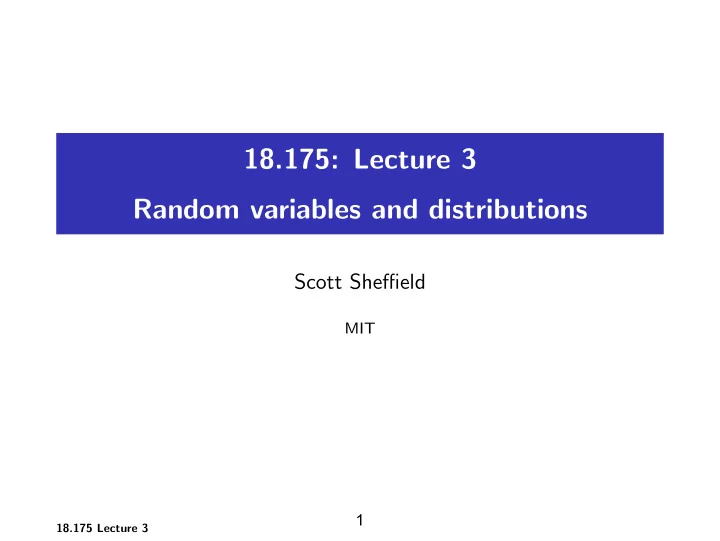

18.175: Lecture 3 Random variables and distributions Scott Sheffield MIT 1 18.175 Lecture 3
Outline Characterizing measures on R d Random variables 2 18.175 Lecture 3
Outline Characterizing measures on R d Random variables 3 18.175 Lecture 3
Recall definitions � Probability space is triple (Ω , F , P ) where Ω is sample space, F is set of events (the σ -algebra) and P : F → [0 , 1] is the probability function. � σ -algebra is collection of subsets closed under complementation and countable unions. Call (Ω , F ) a measure space. � Measure is function µ : F → R satisfying µ ( A ) ≥ µ ( ∅ ) = 0 for all A ∈ F and countable additivity: µ ( ∪ i A i ) = J i µ ( A i ) for disjoint A i . � Measure µ is probability measure if µ (Ω) = 1. � The Borel σ -algebra B on a topological space is the smallest σ -algebra containing all open sets. 4 18.175 Lecture 3
Recall σ -algebra story Want, a priori, to define measure of any subsets of [0 , 1). � � Find that if we allow the axiom of choice and require � � measures to be countably additive (as we do) then we run into trouble. No valid translation invariant way to assign a finite measure to all subsets of [0 , 1). Could toss out the axiom of choice... but we don’t want to. � � Instead we only define measure for certain “measurable sets”. We construct a σ -algebra of measurable sets and let probability measure be function from σ -algebra to [0 , 1]. Borel σ -algebra is generated by open sets. Sometimes � � consider “completion” formed by tossing in measure zero sets. Carathe´ eodory Extension Theorem tells us that if we want to � � construct a measure on a σ -algebra, it is enough to construct the measure on an algebra that generates it. 5 18.175 Lecture 3
Recall construction of measures on R Write F ( a ) = P ( −∞ , a ] . � � Theorem: for each right continuous, non-decreasing function � � F , tending to 0 at −∞ and to 1 at ∞ , there is a unique measure defined on the Borel sets of R with P (( a , b ]) = F ( b ) − F ( a ). Proved using Carathe´ eodory Extension Theorem. � � 6 18.175 Lecture 3
Characterizing probability measures on R d Want to have F ( x ) = µ ( −∞ , x 1 ] × ( ∞ , x 2 ] × . . . × ( −∞ , x n ]. � � Given such an F , can compute µ of any finite rectangle of � � form s ( a i , b i ] by taking differences of F applied to vertices. Theorem: Given F , there is a unique measure whose values � � on finite rectangles are determined this way (provided that F is non-decreasing, right continuous, and assigns a non-negative value to each rectangle). Also proved using Carathe´ eodory Extension Theorem. � � 7 18.175 Lecture 3
Outline Characterizing measures on R d Random variables 8 18.175 Lecture 3
Outline Characterizing measures on R d Random variables 9 18.175 Lecture 3
Defining random variables Random variable is a measurable function from (Ω , F ) to � � ( R , B ). That is, a function X : Ω → R such that the preimage of every set in B is in F . Say X is F -measurable . Question: to prove X is measurable, is it enough to show that � � the pre-image of every open set is in F ? − 1 ( A ) ∈ F for all A ∈ A and A generates S , Theorem: If X � � then X is a measurable map from (Ω , F ) to ( S , S ). Example of random variable: indicator function of a set. Or � � sum of finitely many indicator functions of sets. Let F ( x ) = F X ( x ) = P ( X ≤ x ) be distribution function for � � X . Write f = f X = F x for density function of X . X What functions can be distributions of random variables? � � Non-decreasing, right-continuous, with lim x →∞ F ( x ) = 1 and � � lim x →−∞ F ( x ) = 0. 10 18.175 Lecture 3
Examples of possible random variable laws Other examples of distribution functions: uniform on [0 , 1], � � exponential with rate λ , standard normal, Cantor set measure. Can also define distribution functions for random variables � � that are a.s. integers (like Poisson or geometric or binomial random variables, say). How about for a ratio of two independent Poisson random variables? (This is a random rational with a dense support on [0 , ∞ ).) Higher dimensional density functions analogously defined. � � 11 18.175 Lecture 3
MIT OpenCourseWare http://ocw.mit.edu 18.175 Theory of Probability Spring 2014 For information about citing these materials or our Terms of Use, visit: http://ocw.mit.edu/terms.
MIT OpenCourseWare http://ocw.mit.edu 18.175 Theory of Probability Spring 2014 For information about citing these materials or our Terms of Use, visit: http://ocw.mit.edu/terms.
Recommend
More recommend